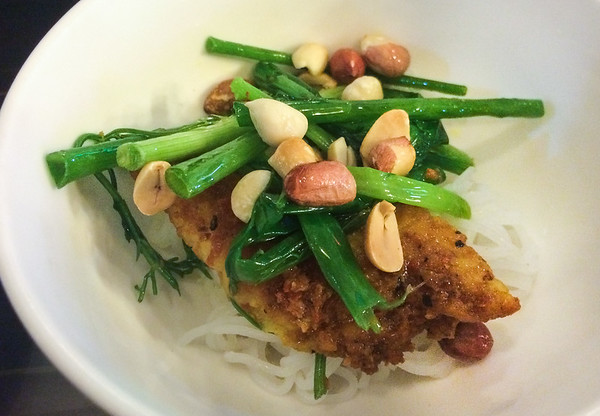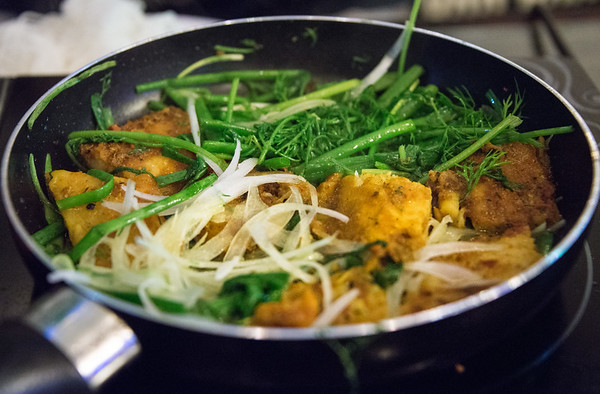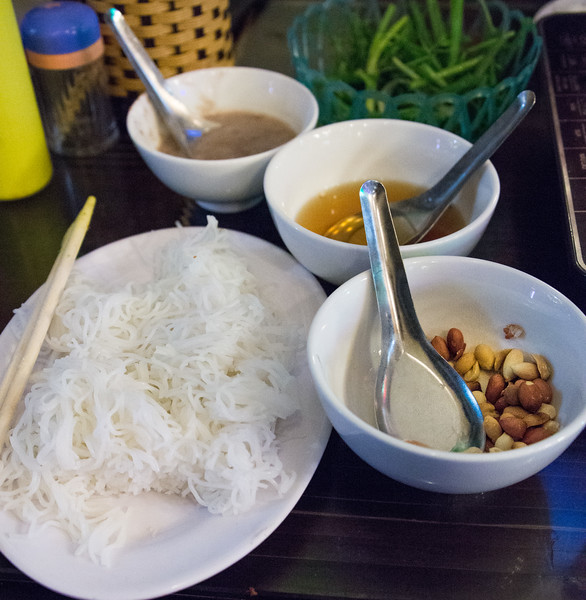
The finished dish, cha ca
Thanks to my husband’s stepfather Luong, who was born and raised in Saigon (now Ho Chi Minh City), I know a bit more than the average red-haired, American food writer about Vietnamese home cooking. For starters, in the country you might make your meals on a stove fueled by coconut husks while in the city you probably cook over a gas flame. Your meals may be as simple as noodles, rice or steamed fish or as complicated as spring rolls, hot and sour soups or meat-filled crepes. Whatever you make, it invariably is fresh, seasonal and local.

Cha ca cooking away in Hanoi
While I understand Vietnamese home cooking, until last month, I didn’t have a good sense of what constituted a traditional restaurant meal. By this I mean something generally eaten outside the home or that bears the signature of one chef or restaurant. That all changed when I traveled to North Vietnam and ate cha ca.
At the beginning of the 20th century, in Hanoi’s old quarter, a shop owned by the Doan family began selling a fish dish known as châ cá; cha ca means “fried fish.” Using white, firm-fleshed fish such as locally caught snakehead or Vietnamese catfish, Mr. Doan marinated slices of fish in a combination of fresh galangal, turmeric, fish sauce and lemon juice. After marinating the fish, he lightly grilled it. He then delivered it, along with bowls of dill, basil, spring onions, peanuts and vermicelli noodles, a frying pan and portable burner, to his customer. In turn, the customer fried the fish, herbs and onions until hot.

Vermicelli noodles, shrimp paste sauce, scallions, fish sauce & peanuts all go into cha ca.
Once the ingredients had finished cooking, they were piled atop vermicelli noodles. Dressed with fish and shrimp paste sauces, the dish was finished with a smattering of roasted peanuts. With that the diner could dig into his fish dinner at Mr. Doan’s restaurant, Cha Ca La Vong.
Due to exhaustion, traffic and the confusion brought on by both (8 flights in 11 days can be a killer), I didn’t get my first taste of cha ca at its birthplace, Cha Ca La Vong. Instead I ended up across the street at Cha Ca La Luong. Seated outside at a standard, child-sized dining table on equally small stools, we watched as our server sautéed the greens and pre-cooked fish in a steaming hot, non-stick pan. The experience was memorable, the resulting dish was, too. Cha ca is a pleasing combination of textures and savory flavors and, although associated with restaurant cooking, it can be made at home.
CHA CA
Note: If you cannot find fresh galangal, substitute fresh ginger. Likewise, if fresh turmeric is unavailable, increase the amount of ground turmeric to 2 1/2 teaspoons.
Serves 4
2-inch piece fresh galangal, peeled
3-inch piece fresh turmeric, peeled
1 teaspoon ground turmeric
1 clove garlic
1 1/2 pounds Alaskan cod fillets, snakehead fillets or other firm, white-fleshed fish
1 tablespoon sugar
Juice of 1/2 lemon
1/4 cup fish sauce
1/4 teaspoon dried chili flakes
4 ounces rice/vermicelli noodles
3 tablespoons grapeseed or canola oil, divided
1/2 teaspoon salt
2 bunches scallions, trimmed to 4-inch lengths
1 small white onion, sliced
1/2 cup Thai basil leaves
2/3 cup fresh dill
1/3 cup roasted peanuts, roughly chopped
Shrimp paste sauce, optional, to taste
Place the galangal, fresh and ground turmeric and garlic in the bowl of a food processor or blend and pulse into a paste has formed. Scoop the paste from the bowl, spread it over the fish slices, cover and refrigerate for 1 hour.
As the fish is marinating, whisk together the sugar, lemon juice, fish sauce and chili flakes. Set aside.
Bring a small pot of water to a boil. Add the rice/vermicelli noodles and cook for 1 minute. Place the noodles in a colander and set aside.
Remove the fish from the refrigerator. Heat half the oil in a non-stick pan over medium heat. Add the fish and cook for 1 to 2 minutes before flipping over the slices and cooking on the other side for 1 to 2 minutes. Remove the fish from the pan and set it aside on a plate.
Heat the remaining oil in the pan over medium heat. Add half the scallions, the onion, basil and dill and season with salt. Reduce the heat to medium-low and sauté for 2 to 3 minutes, until soft. Add the fish back to the pan and cook for another 1 to 2 minutes, until warmed.
Spoon equal amounts of noodles into 4 bowls. Place the greens and fish in the bowls. Sprinkle the peanuts over top. Serve with the fish sauce and optional shrimp paste sauce.
1 Comment